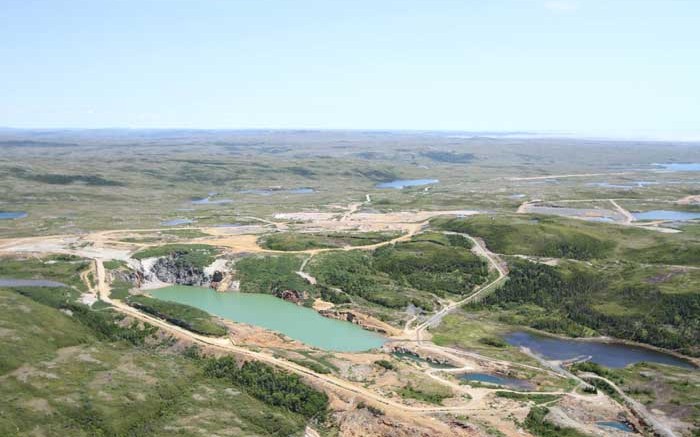Coastal Gold (TSXV: COD) is steaming ahead with a resource definition program at its 100% owned Hope Brook gold project in southwestern Newfoundland.
The company, formerly called Castillian Resources, has initiated a 4,250-metre program to expand its resource with an update expected by year-end, followed by a preliminary economic assessment (PEA) early next year to determine whether the past-producing property is technically viable to develop and mine.
“The main thing is really to demonstrate through the resource update and the PEA that this is indeed an attractive project economically,” says Bill Pearson, the company’s president and CEO. “I don’t think anyone doubts the exploration potential here, we documented that well. The question mark that people want to know is: ‘Is this economic at current gold prices, or is it one of these deposits that needs $2,000 gold to work?’ I certainly don’t believe that is the case. And that’s our mission.”
As part of its 2013 program, Coastal has two drills turning on the project, with a focus on testing the footwall target and the southwest pit extension to expand and possibly upgrade the open-pittable resource that the junior has defined at the deposit to date.
Coastal optioned into the property in February 2010 and initiated a drill program that September, which marked the first exploration work since 1996 on the property. To date, the little-known junior has drilled 39,000 metres and published two resource estimates. The latest estimate, released in October 2012, outlined 2.4 million indicated tonnes grading 1.48 grams per tonne gold for 590,000 oz., with another 8.2 million inferred tonnes at 2.07 grams for 548,000 oz. Most of these ounces fall within an open-pittable constraining shell defined at a US$1,400 per oz. gold price and a cut-off grade of 0.5 gram gold.
Pearson notes the grades in the previous estimate were diluted, as its resource model included low-grade, dyke mineralized zones. But he expects improved grades in the upcoming estimate, as the company has tightened its geological model by eliminating areas of waste and some of the dykes.
“The other thing that is not in our resource that I’m hoping we will get in the next one is copper,” he adds. Royal Oak Mines, the previous operator at Hope Brook, had produced saleable copper from the operation, but the quantity and grades were not recorded.
That said, Pearson notes all of Coastal’s drill holes have been returning copper values, with the best hole to date cutting 204 grams gold and 7.98% copper over 1.5 metres in 2011.
While the company didn’t see grades like that in its 6,000-metre program in 2012, it did make some notable finds, including intersecting the major, near-surface Connector zone that extends for 1.2 km along strike. The thickness and character of the zone is comparable to that of the former Hope Brook mine and the 240 zone. It also confirmed that the major silicified zones on the property extended for a strike length of 3.4 km, and were open along strike and at depth.
Pearson says the property has a lot of exploration upside, as the previous operators conducted little work outside of the old mine. The Selco division of BP Resources Canada discovered the Hope Brook deposit in 1983 and mined it from 1987 to 1991, producing 305,000 oz. gold. BP then sold the combined open-pit and underground operation to Royal Oak as part of its plan to leave the mining industry. Royal Oak operated the Hope Brook mine from 1992 to mid-1997, generating 447,000 oz. gold from the underground, plus copper credits. The total gold ounces produced over the decade were 752,000 oz.
Royal Oak closed the mine in 1997 because it had depleted the reserves, but it didn’t complete an environmental reclamation of the site because it ran into financial problems and filed for bankruptcy in 1999. So the provincial government gained ownership of the Hope Brook property and carried out reclamation work from 2002 to 2007, which is another reason why the project had been underexplored, until Coastal arrived.
“Most people assume that because this mine was in production for ten years, everything around it must have been drilled. But that’s not case,” Pearson says. He points out that the previous operators did little drilling outside of the main deposit, and all the deeper holes they drilled were too short. “They had assumed the deposit is more shallowly dipping. Well, it isn’t — it is much steeper.”
Gold mineralization on the property mainly occurs in silicified, late Proterozoic sedimentary and volcanic rocks of the Whittle Hill Sandstone and Third Pond Tuff successions. Pearson says there are two stages of silicification at the deposit: an early pervasive, lower-grade stage that runs between 0.5 and 1 gram gold, with zones ranging from 15 to 80 metres wide; and another later, higher-grade stage that carries 2 to over 5 grams gold, plus significant copper in zones ranging from 5 to 25 metres thick, he says.
The later stage is what the previous operators were mining, and what Coastal is now targeting. The company has also teamed up with researchers at the University of Western Ontario and the Memorial University of Newfoundland to better understand the nature and origin of the higher-grade mineralization.
Meanwhile, the company’s drilling activities are fuelled by the $2.9 million in cash it got from acquiring Ridgemont Iron Ore in late June. “That was a good deal for both parties. Ridgemont was looking for a project and had some cash, and we have an excellent project that needed cash,” Pearson says, adding that the funds are enough to finish off the PEA. The firm has initiated follow-up metallurgical testing on the deposit to support the study.
Once the PEA comes out, Pearson believes Coastal’s shares will gain some momentum. The junior recently closed at 3.5¢ within a 52-week range of 2¢ to 20¢.


Be the first to comment on "Coastal Gold keeps the drills turning at Hope Brook"